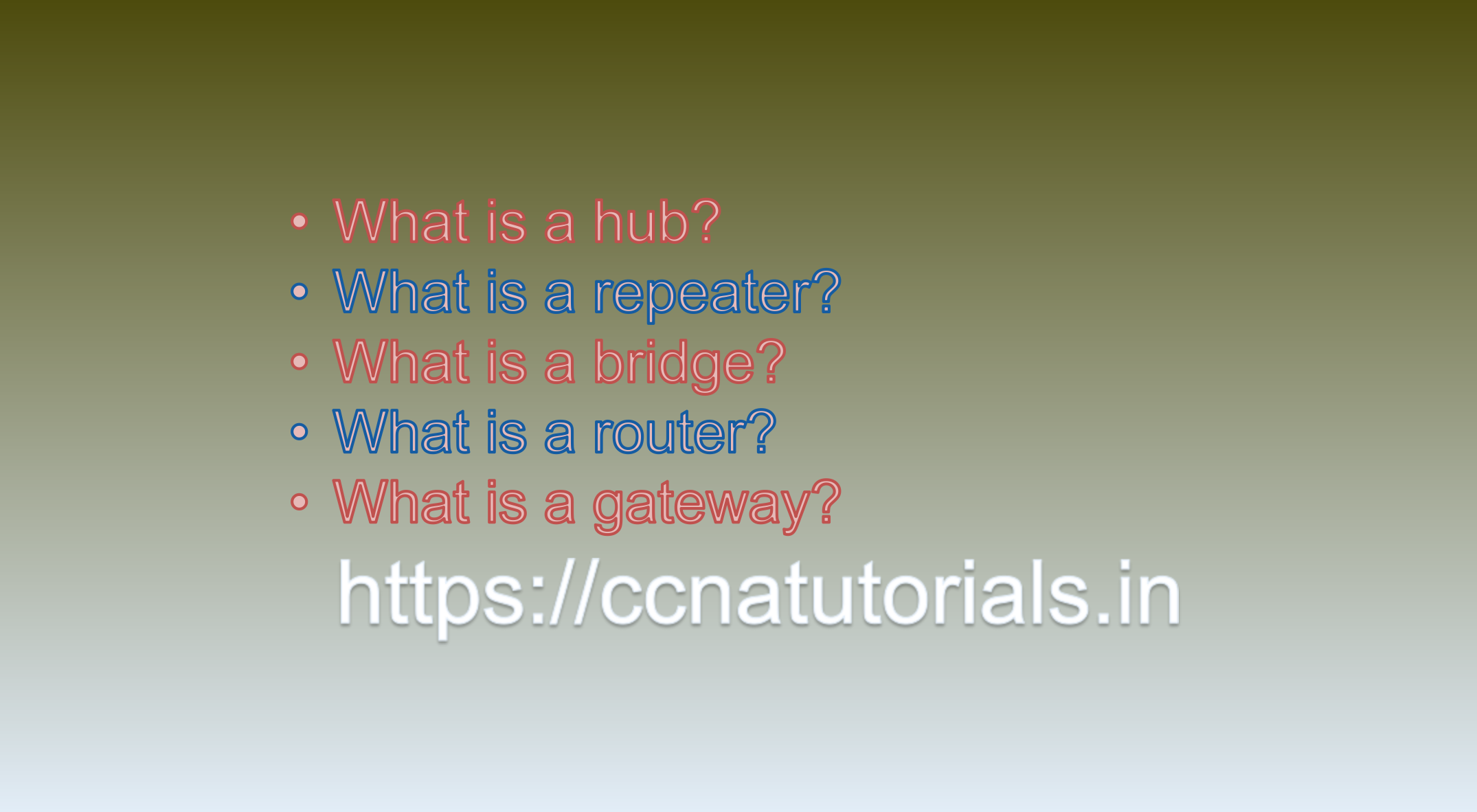Contents of this article
In this article, I describe some CCNA sample questions for practice before appearing in the CCNA 200-301 exam. The following questions are basic questions and related to the CCNA sample questions set 17. There are multiple sample questions set on this website for prior practice online. All questions are described with relevant answers. You can take the following questions and answer as reference for CCNA 200-301 exam. You may also need to do more practice with other websites and books to practice the CCNA sample questions set 17.
Question 1. What is a hub?
A hub is a network device that connects multiple devices together in a local area network (LAN). A hub works at the physical layer (layer 1) of the OSI model and is used to extend the range of a network by amplifying and regenerating signals.
A hub receives incoming data packets from one device and broadcasts them to all other devices connected to the hub, regardless of whether they are the intended recipient or not. This is known as a “broadcast domain.” As a result, all devices connected to the hub share the same bandwidth, which can cause network congestion and slow down data transmission speeds.
Hubs have largely been replaced by switches, which work at the data link layer (layer 2) and are more efficient in managing network traffic. However, hubs may still be used in small, simple networks where cost is a primary concern. This is the answer to question 1 of CCNA sample questions set 17.
Question 2. What is a repeater?
A repeater is a network device that amplifies and regenerates signals to extend the range of a network. It works at the physical layer (layer 1) of the OSI model and is used to overcome the limitations of distance and signal degradation that occur when transmitting data over long distances.
A repeater receives an incoming signal, amplifies it, and then retransmits it to the next device in the network. This process helps to extend the range of the network by overcoming attenuation and noise that can weaken the signal over long distances.
Repeaters are commonly used in telecommunications and computer networks to increase the coverage area of wireless networks or to extend the range of wired networks. However, they do not provide any intelligence or filtering capabilities and cannot distinguish between different types of network traffic. As a result, they are often used in conjunction with other networking devices such as switches and routers. This is the answer to question 2 of CCNA sample questions set 17.
Question 3. What is a bridge?
A bridge is a network device that connects two or more network segments together and forwards data packets between them. It operates at the data link layer (layer 2) of the OSI model and is used to create a single network from multiple smaller networks or to divide a larger network into smaller segments for better traffic management.
A bridge works by examining the destination address of a data packet and forwarding it only to the segment where the destination device is located. This helps to reduce network congestion and improve the overall performance of the network.
Bridges can be used to connect similar or dissimilar network technologies, such as Ethernet and Token Ring, and can be configured to operate in either transparent or source-route mode. In transparent mode, the bridge operates as a “bump in the wire” and forwards data packets without modifying their contents. In source-route mode, the bridge uses information in the packet header to determine the path that the packet should take through the network.
Today, bridges have largely been replaced by switches, which provide greater functionality and performance. However, bridges may still be used in certain legacy network environments or as a cost-effective alternative to switches in smaller networks. This is the answer to question 3 of CCNA sample questions set 17.

Question 4. What is a router?
A router is a network device that connects multiple networks together and forwards data packets between them. It operates at the network layer (layer 3) of the OSI model and is used to direct network traffic between different networks.
A router works by examining the destination IP address of a data packet and determining the most efficient path for the packet to take through the network. This process is known as routing, and it involves analyzing the routing table to determine the next hop or hops on the path to the destination device.
Routers can be used to connect networks of different types, such as LANs and WANs, and can support a wide range of network protocols, including TCP/IP, IPX/SPX, and AppleTalk. They also provide a variety of advanced features, such as Quality of Service (QoS), Network Address Translation (NAT), and Virtual Private Network (VPN) support.
Today, routers are a key component of most computer networks and are used to connect devices to the Internet, to connect different branches of an organization, and to provide secure remote access to networks. This is the answer to question 4 of CCNA sample questions set 17.
Question 5. What is a gateway?
A gateway is a network device that provides a bridge between two different networks, allowing them to communicate with each other. It is a type of router that operates at the network layer (layer 3) of the OSI model and can connect networks of different types, such as a LAN and the Internet.
A gateway is typically used to connect a private local area network (LAN) to a public wide area network (WAN), such as the Internet. It acts as an interface between the LAN and the WAN, allowing devices on the LAN to communicate with devices on the WAN and vice versa.
In addition to routing data packets between networks, a gateway may also provide other network services, such as network address translation (NAT), firewall protection, and virtual private network (VPN) support.
Gateways are commonly used in enterprise networks to connect remote offices and employees to the company’s main network, as well as in homes and small businesses to connect to the Internet. This is the answer to question 5 of CCNA sample questions set 17.
Conclusion for CCNA sample questions set 17
In this article, I described 5 questions with answers related to CCNA 200-301 exam. I hope you found these questions helpful for the practice of the CCNA 200-301 exam. You may drop a comment below or contact us for any queries related to the above questions and answers for CCNA 200-301. Share the above questions If you found them useful. Happy reading!!






